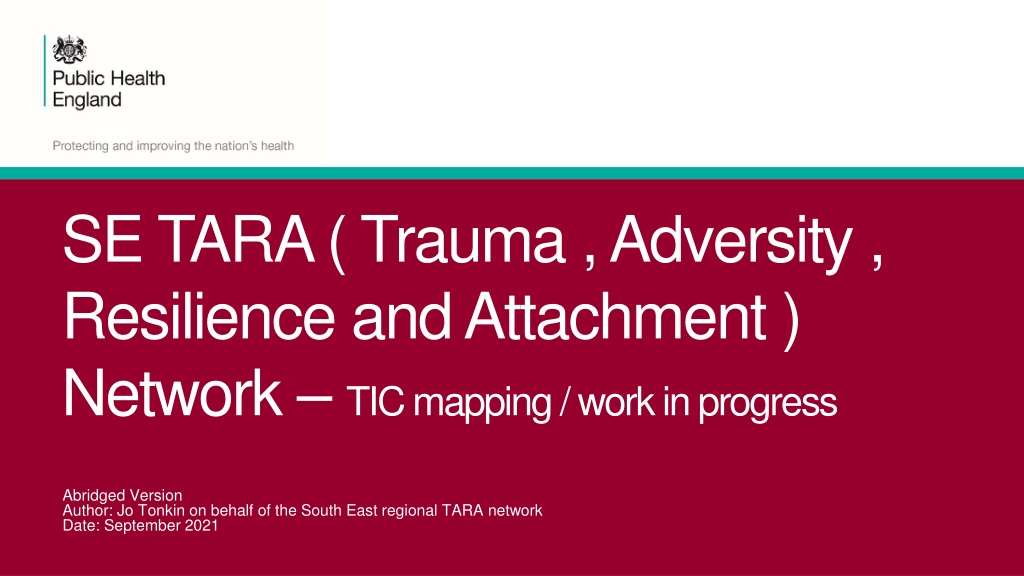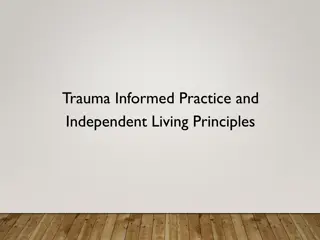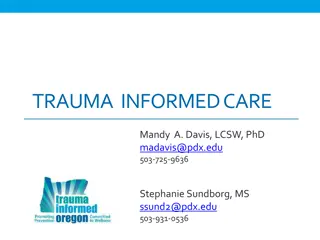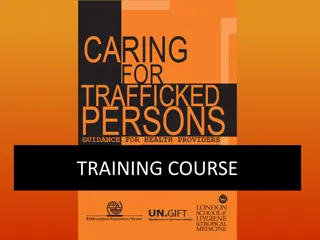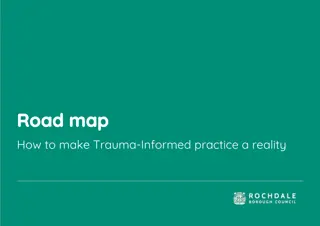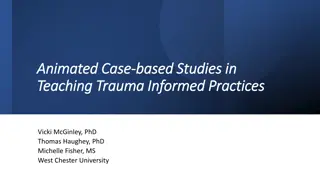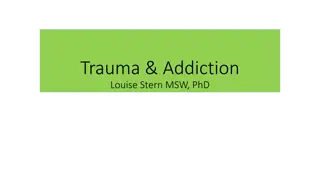Understanding Trauma-Informed Care (TIC) and Resilience in the SE TARA Network
This work-in-progress document discusses the aims and objectives of the SE TARA Network in establishing a common language and approach to Trauma-Informed Care (TIC). It highlights strengths and limitations of unifying TIC responses, defines trauma and trauma-informed approaches, and outlines key principles for trauma-informed care in organizations. The document emphasizes the importance of universal understanding and practices in responding to trauma while acknowledging the variations in implementation across systems and services.
Download Presentation

Please find below an Image/Link to download the presentation.
The content on the website is provided AS IS for your information and personal use only. It may not be sold, licensed, or shared on other websites without obtaining consent from the author. Download presentation by click this link. If you encounter any issues during the download, it is possible that the publisher has removed the file from their server.
E N D
Presentation Transcript
SE TARA ( Trauma , Adversity , Resilience and Attachment ) Network TIC mapping / work in progress Abridged Version Author: Jo Tonkin on behalf of the South East regional TARA network Date: September 2021
Aim and Objectives The aim is to identify a common language and broad approach to TIC to inform a framework for work across SE building on existing scoping undertaken by the SE ACE Network and the Trauma Informed COVID Response group. By : Providing commonly used defintions By collecting together and categorising resources used to describe, self assess and implement TIC By mapping the systems and sites where TIC is being applied Identify questions for additional research and consider communication options TARA Network Mapping 2
Strengths and limitations of unifying the response to Trauma Informed Care (TIC) : Strengths: Limitations: TIC will be most successful when the approach is universally and proportionately understood and practiced. TIC will be implemented differently in different systems and services. The understanding and application of TIC will vary across systems and services . TIC is an approach which can be applied across systems, in places , across services and in individual interactions . TIC requires a change in culture that will be achieved not through the implementation of a set of standards but a cycle of continual reflection and improvement . Much has still to be learnt about the implementation and impact of TIC. TIC is likely to benefit the workforce as well patients , service users and communities. TARA Network Mapping 3
Some trauma definitions ( agreed by the COVID trauma group) Trauma: Occurs when a person experiences or witnesses a physically or emotionally harmful or life threatening event. It may be a single incident or a prolonged or repeated experience (known as complex trauma). Trauma informed: Universal knowledge and understanding about trauma and its effects on individuals, families, communities and society. Trauma Responsive: Policies and practices in place to minimise damage and maximize opportunities for healthy development. While many organisations are trauma informed becoming trauma-responsive means looking at all aspects of an organisations training and recruitment, programmes, environment, language, and values and involving and supporting all staff to better serve clients who have experienced trauma. 4 TARA Network Mapping
Trauma informed approaches SAMHSA A program, organization, or system that is TI realises the widespread impact of trauma and understand potential paths for recovery; recognises the signs and symptoms of trauma in clients, families, staff, and others involved with the system; and responds by fully integrating knowledge about trauma into policies, procedures, and practices, and seeks to actively resist re-traumatisation 6 key principles 1. Peer support to promote recovery and healing 2. Safety staff and users feel physically and psychologically safe 3. Trustworthiness and transparency operations and decisions with the goal to achieve to trust 4. Collaboration and mutuality shared power and role across the organisation and system 5. Empowerment, voice and trust shared decision making, promoting self-advocacy 6. Cultural, historical and gender issues policies and processes are responsive to racial, ethnic and cultural needs 10 domains for the implementation of a TIA across any organisation or system: governance and leadership; policy, physical environment; engagement and involvement; cross sector collaboration; (screening), assessment, treatment services; training and workforce development; progress monitoring and quality assurance; financing and evaluation 5 Trauma informed insights in the context of COVID-19
What that means for trauma informed practice : Recognise the impact of traumatic events on functioning Remember that trauma responses service a purpose they are attempts at coping View recovery from trauma as a primary goal Maximise service users control over their life Prioritise relationships and building trust Create a climate of safety , respect and acceptance Adaptation over symptoms and resilience over pathology Minimise potential for re-traumatisation Situate service users life experience in their cultural context Be aware of your own feelings and response to their trauma ( Elliot , Bjelajac, Fallot , Markoff and Reed, 2005) TARA Network Mapping 6
Adverse Childhood Experiences ACEs include a complex set of related childhood experiences including direct abuse i.e. sexual, emotional, and physical and neglect and indirect abuse i.e. household dysfunction, domestic violence, drug and alcohol misuse, mental ill health, criminality, or children who live in care. Approximately half of the English population have experienced one or more ACEs, although this varies according to the type of ACE. TARA Network Mapping 7
Resilience The ability to overcome adversity and to avoid its damaging effects. It can be a feature of individuals, groups or communities. - Individual: self-esteem, self-efficacy, internal locus of control, and a positive outlook - Family: strong parent-child relationships, and family cohesion - Community: peer networks, supportive communities and supportive school environment 8 TARA Network Mapping
Anticipated outcomes of a TIC service : Draft logic model of trauma-informed primary and community mental healthcare. TI, trauma- informed. Adapted from Germ n in Dawson S, Bierce A, Feder G, et al. Trauma- informed approaches to primary and community mental health care: protocol for a mixed- methods systematic review. BMJ Open 2021;11:e042112. doi:10.1136/ bmjopen-2020-042112 TARA Network Mapping 9
Some useful resources Trauma informed practice guide for professionals https://youngminds.org.uk/media/3091/adversity-and-trauma-informed- practice-guide-for-professionals.pdf Trauma informed information for schools:https://www.traumainformedschools.co.uk/resources Anna Freud National Centre for Children and Families https://www.annafreud.org/ Resources to support the signs of trauma: https://beaconhouse.org.uk/resources/ Centre for Mental Health briefings: https://www.centreformentalhealth.org.uk/sites/default/files/2020- 05/CentreforMentalHealth_Briefing56_Trauma_MH_Coronavirus_2.pdf Trauma informed Oregon - COVID-19 Considerations for a Trauma Informed Response for Work Settings (Organizations/Schools/Clinics) Resources from LGA on managing the wellbeing of staff https://www.local.gov.uk/our-support/workforce-and-hr- support/wellbeing TARA Network Mapping 10
